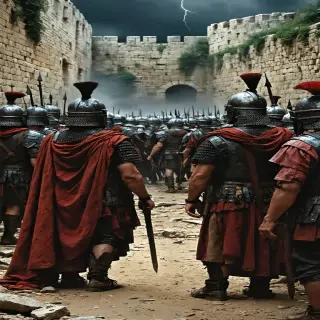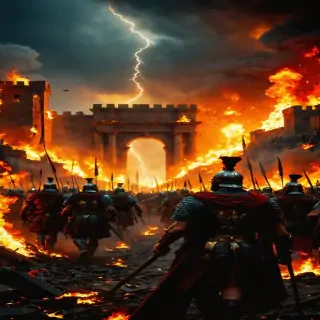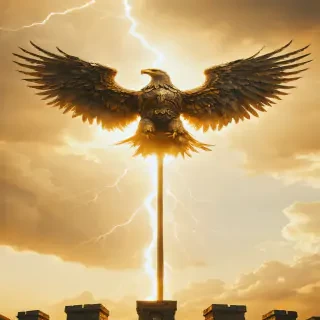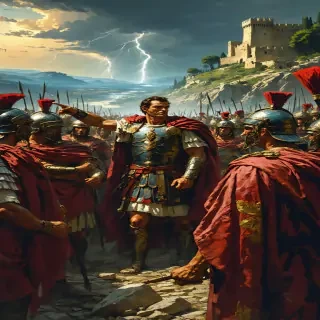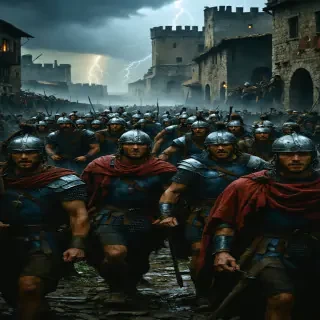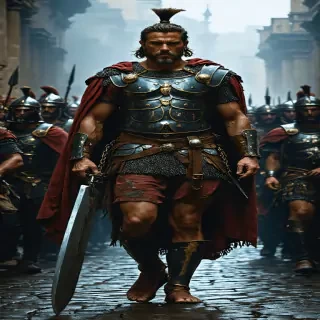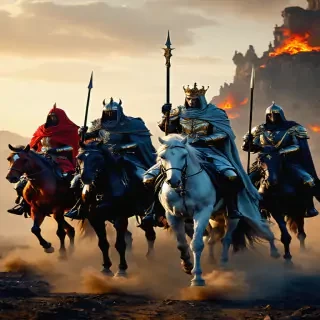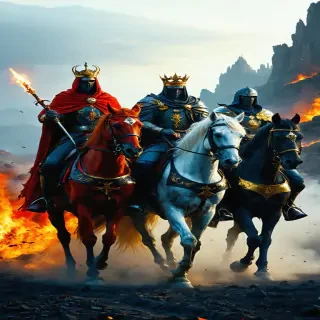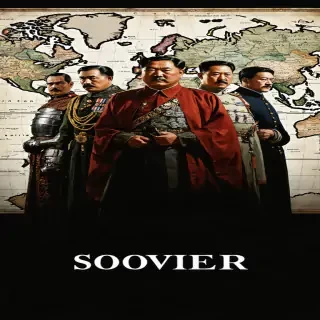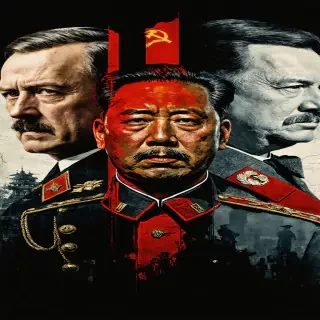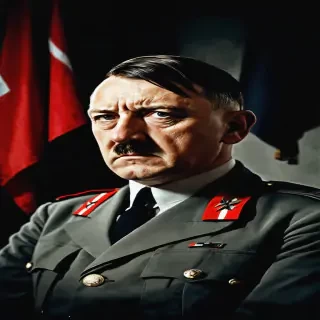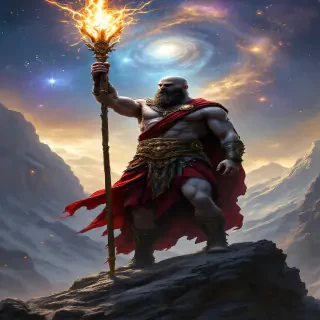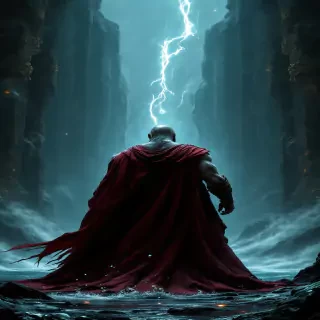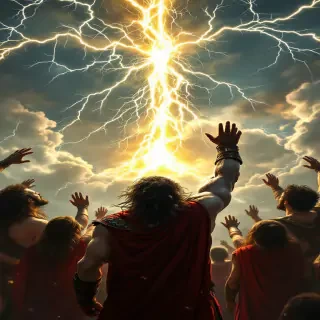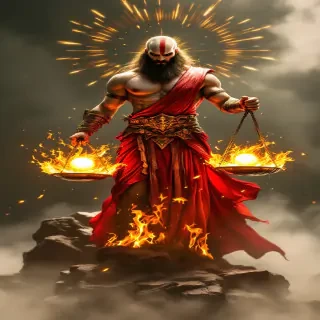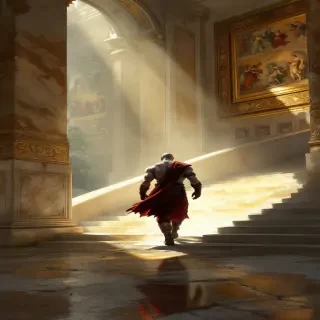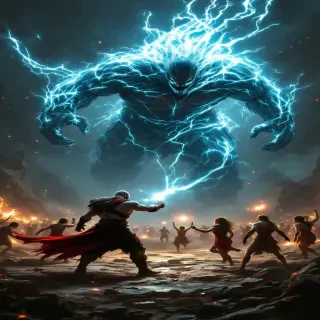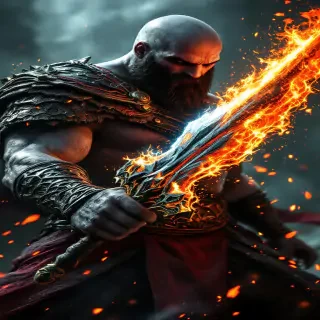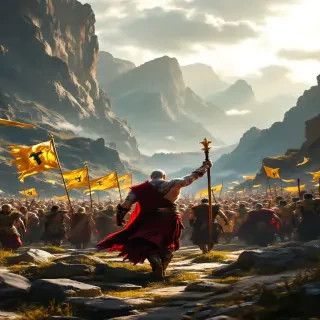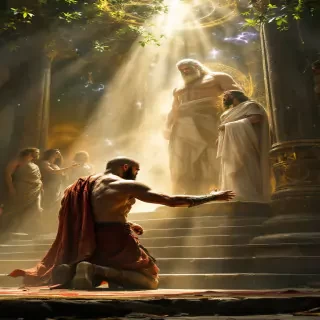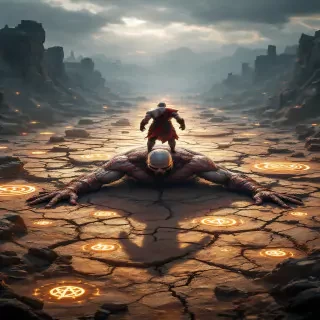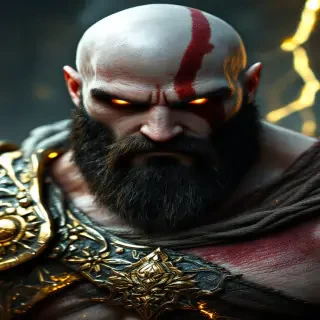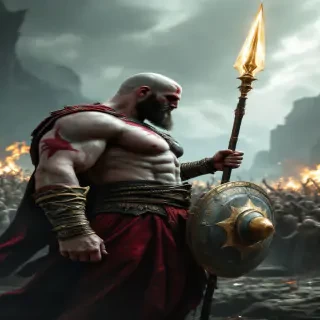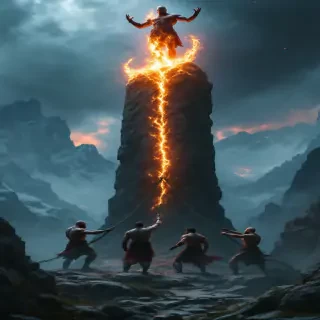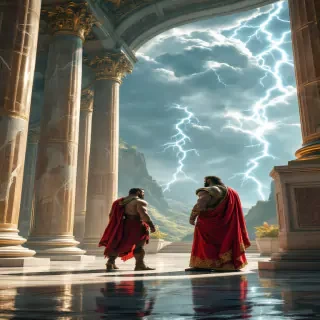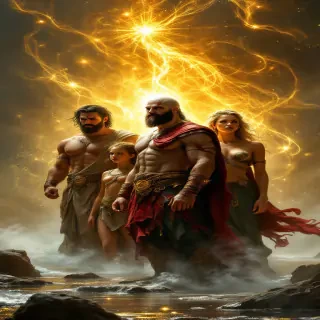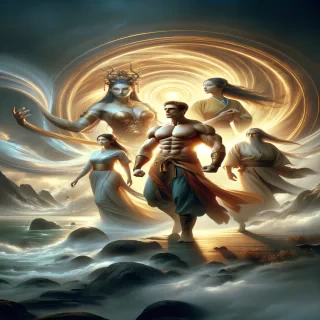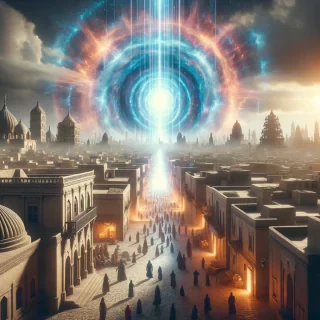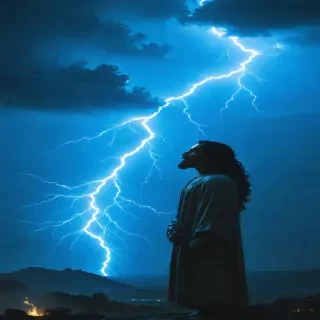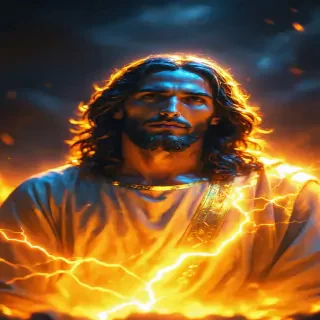A scene of the abandoned women and children between the walls, surrounded by cold Roman soldiers.
The moment Roman soldiers storm the gates of Alesia, with flames and chaos consuming the city.
A symbolic representation of Roman power, with the eagle standard held high as the fortifications encircle the Gallic city.
Caesar commanding his legions, pointing toward Alesia while strategizing with his generals.
The Gallic people struggling inside the besieged city, their faces showing despair as resources run out.
"A solemn depiction of Vercingetorix in chains, being paraded through Rome before his eventual execution.
Create an ultra-realistic cover image featuring four distinct riders, each representing one of the Four Horsemen of the Apocalypse. Place them side by side, riding boldly across a desolate, apocalyptic landscape. Each horseman should be highly detailed: The First Horseman on a majestic white horse, wearing a golden crown and holding a glowing, elegant bow, representing conquest and false peace. The Second Horseman on a fiery red horse, wielding a massive, bloodstained sword, symbolizing war and bloodshed. The Third Horseman on a sleek black horse, carrying a detailed, ornate scale in one hand, signifying famine and scarcity. The Fourth Horseman on a pale, ghostly greenish-white horse, shrouded in a dark hood, with a chilling skeletal figure, representing death and destruction. The landscape should be barren and filled with ruins, with skeletal remains scattered across the ground. The sky above should be ominous, swirling with dark clouds, fiery reds, and pale greens, creating a sense of doom and despair. Faint, glowing light should break through the clouds to illuminate the four riders, highlighting their power and ominous presence. The composition should be dynamic, with the horses in mid-gallop, their manes and tails flowing dramatically, emphasizing movement and chaos
Create an ultra-realistic cover image featuring four distinct riders, each representing one of the Four Horsemen of the Apocalypse. Place them side by side, riding boldly across a desolate, apocalyptic landscape. Each horseman should be highly detailed: The First Horseman on a majestic white horse, wearing a golden crown and holding a glowing, elegant bow, representing conquest and false peace. The Second Horseman on a fiery red horse, wielding a massive, bloodstained sword, symbolizing war and bloodshed. The Third Horseman on a sleek black horse, carrying a detailed, ornate scale in one hand, signifying famine and scarcity. The Fourth Horseman on a pale, ghostly greenish-white horse, shrouded in a dark hood, with a chilling skeletal figure, representing death and destruction. The landscape should be barren and filled with ruins, with skeletal remains scattered across the ground. The sky above should be ominous, swirling with dark clouds, fiery reds, and pale greens, creating a sense of doom and despair. Faint, glowing light should break through the clouds to illuminate the four riders, highlighting their power and ominous presence. The composition should be dynamic, with the horses in mid-gallop, their manes and tails flowing dramatically, emphasizing movement and chaos
An ultra-realistic cover image combining the portraits of five historical figures, each representing a significant era of power and control. The figures are arranged in a balanced composition, with King Leopold II in regal attire, Adolf Hitler in formal military uniform, Genghis Khan in traditional Mongol armor, Joseph Stalin in a Soviet military tunic, and Mao Zedong in revolutionary attire. The background features a muted, darkened world map, with shadows of their actions subtly reflected in the environment. The lighting is dramatic, casting a somber tone over the portraits, emphasizing the weight of their legacies in history.
An ultra-realistic cover image combining the portraits of five historical figures, each representing a significant era of power and control. The figures are arranged in a balanced composition, with King Leopold II in regal attire, Adolf Hitler in formal military uniform, Genghis Khan in traditional Mongol armor, Joseph Stalin in a Soviet military tunic, and Mao Zedong in revolutionary attire. The background features a muted, darkened world map, with shadows of their actions subtly reflected in the environment. The lighting is dramatic, casting a somber tone over the portraits, emphasizing the weight of their legacies in history.
An ultra-realistic portrait of Adolf Hitler, capturing his signature side-parted hair and small mustache. He is depicted in a crisp Nazi military uniform with a swastika armband, set against a shadowy background with faint red and black banners. His intense gaze conveys a chilling sense of control and ambition.
Kratos depicted as the enforcer of divine law, holding a radiant staff of power, standing on the peak of Olympus with the stars and cosmos swirling around him.
A mythic moment of Kratos standing before the gates of the underworld, with Styx's dark waters swirling ominously and divine fire in his eyes.
Kratos with his siblings, raising their hands in unison to the heavens, invoking their divine strength as the Olympian sky crackles with lightning.
A symbolic depiction of Kratos balancing the scales of justice, surrounded by flames and glowing celestial orbs representing authority and discipline.
Kratos walking through the halls of Olympus, his shadow cast long and foreboding against the golden marble walls adorned with frescoes of past battles.
A battle scene with Kratos and his siblings fighting a colossal titan, their divine power illuminating the dark, chaotic battlefield.
Kratos wielding an enchanted weapon forged by Hephaestus, the blade emanating fiery energy and surrounded by sparks of divine power.
Kratos standing at the edge of Mount Olympus, gazing into the mortal realm, with an ethereal glow and a cascading river of clouds below.
Kratos leading an army of divine warriors across a mountainous terrain, golden banners fluttering in the wind and Olympus visible in the distance.
Kratos in a mythological scene, kneeling before the throne of Zeus, bathed in celestial light with other Olympian gods observing solemnly.
Kratos standing victorious over a subdued titan, surrounded by a cracked battlefield and glowing divine symbols etched in the earth.
A portrait of Kratos, clad in radiant bronze armor, with a stern expression and glowing eyes resembling Zeus’s lightning.
Kratos alongside Nike, wielding a gleaming spear and shield, with a battlefield of fallen titans in the distance, symbolizing their shared divine strength and victory.
Kratos and Hephaestus chaining Prometheus to a towering rock under a stormy sky, flames of divine fire reflecting on their faces, with the boundless mountains of the world behind them.
Kratos receiving orders from Zeus in the grand palace of Olympus, with lightning bolts illuminating the clouds and marble columns glistening in the divine light.
Kratos and his siblings, Nike, Bia, and Zelos, standing on the shores of the Styx River, surrounded by a divine golden aura, with swirling mists and a celestial backdrop.
Kratos and his siblings, Nike, Bia, and Zelos, standing on the shores of the Styx River, surrounded by a divine golden aura, with swirling mists and a celestial backdrop. 9:16
A dramatic depiction of the moment the portals fully activate, with beams of light shooting skyward, illuminating the Vatican skyline as people in the streets react with awe and fear.
Jesus amen
Jesus close to the background
Jesus
Lorem ipsum dolor sit, amet consectetur adipisicing elit. Deleniti esse reprehenderit voluptates obcaecati placeat architecto hic ratione ducimus nemo.
Lorem Ipsum is simply dummy text of the printing and typesetting industry. Lorem Ipsum has been the industry's standard dummy text ever since the 1500s, when an unknown printer took a galley of type and scrambled it to make a type specimen book. It has survived not only five centuries, but also the leap into electronic typesetting, remaining essentially unchanged. It was popularised in the 1960s with the release of Letraset sheets containing Lorem Ipsum passages, and more recently with desktop publishing software like Aldus PageMaker including versions of Lorem Ipsum.
It is a long established fact that a reader will be distracted by the readable content of a page when looking at its layout. The point of using Lorem Ipsum is that it has a more-or-less normal distribution of letters, as opposed to using 'Content here, content here', making it look like readable English. Many desktop publishing packages and web page editors now use Lorem Ipsum as their default model text, and a search for 'lorem ipsum' will uncover many web sites still in their infancy. Various versions have evolved over the years, sometimes by accident, sometimes on purpose (injected humour and the like).
Contrary to popular belief, Lorem Ipsum is not simply random text. It has roots in a piece of classical Latin literature from 45 BC, making it over 2000 years old. Richard McClintock, a Latin professor at Hampden-Sydney College in Virginia, looked up one of the more obscure Latin words, consectetur, from a Lorem Ipsum passage, and going through the cites of the word in classical literature, discovered the undoubtable source. Lorem Ipsum comes from sections 1.10.32 and 1.10.33 of "de Finibus Bonorum et Malorum" (The Extremes of Good and Evil) by Cicero, written in 45 BC. This book is a treatise on the theory of ethics, very popular during the Renaissance. The first line of Lorem Ipsum, "Lorem ipsum dolor sit amet..", comes from a line in section 1.10.32.
The standard chunk of Lorem Ipsum used since the 1500s is reproduced below for those interested. Sections 1.10.32 and 1.10.33 from "de Finibus Bonorum et Malorum" by Cicero are also reproduced in their exact original form, accompanied by English versions from the 1914 translation by H. Rackham.
There are many variations of passages of Lorem Ipsum available, but the majority have suffered alteration in some form, by injected humour, or randomised words which don't look even slightly believable. If you are going to use a passage of Lorem Ipsum, you need to be sure there isn't anything embarrassing hidden in the middle of text. All the Lorem Ipsum generators on the Internet tend to repeat predefined chunks as necessary, making this the first true generator on the Internet. It uses a dictionary of over 200 Latin words, combined with a handful of model sentence structures, to generate Lorem Ipsum which looks reasonable. The generated Lorem Ipsum is therefore always free from repetition, injected humour, or non-characteristic words etc.
